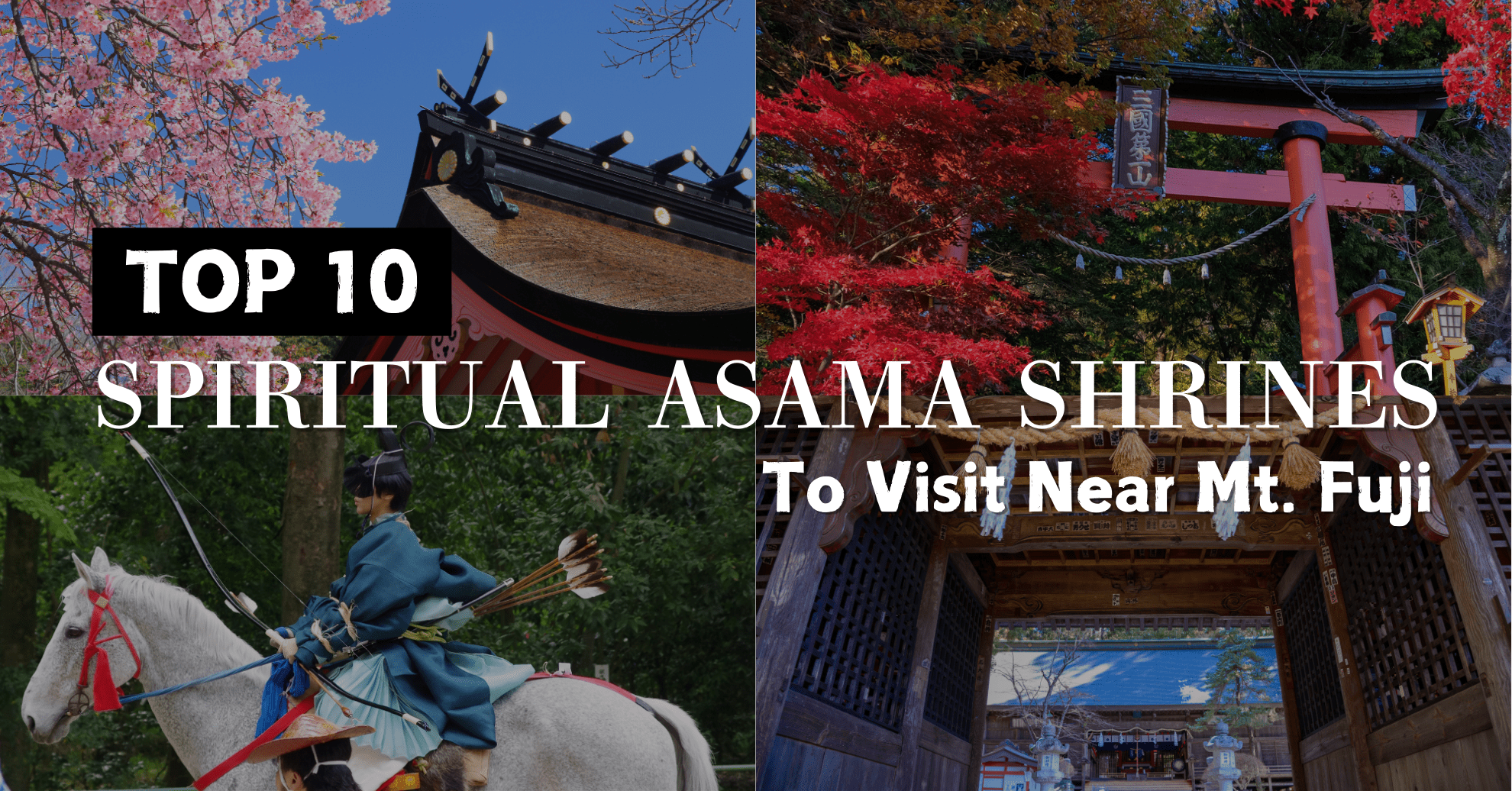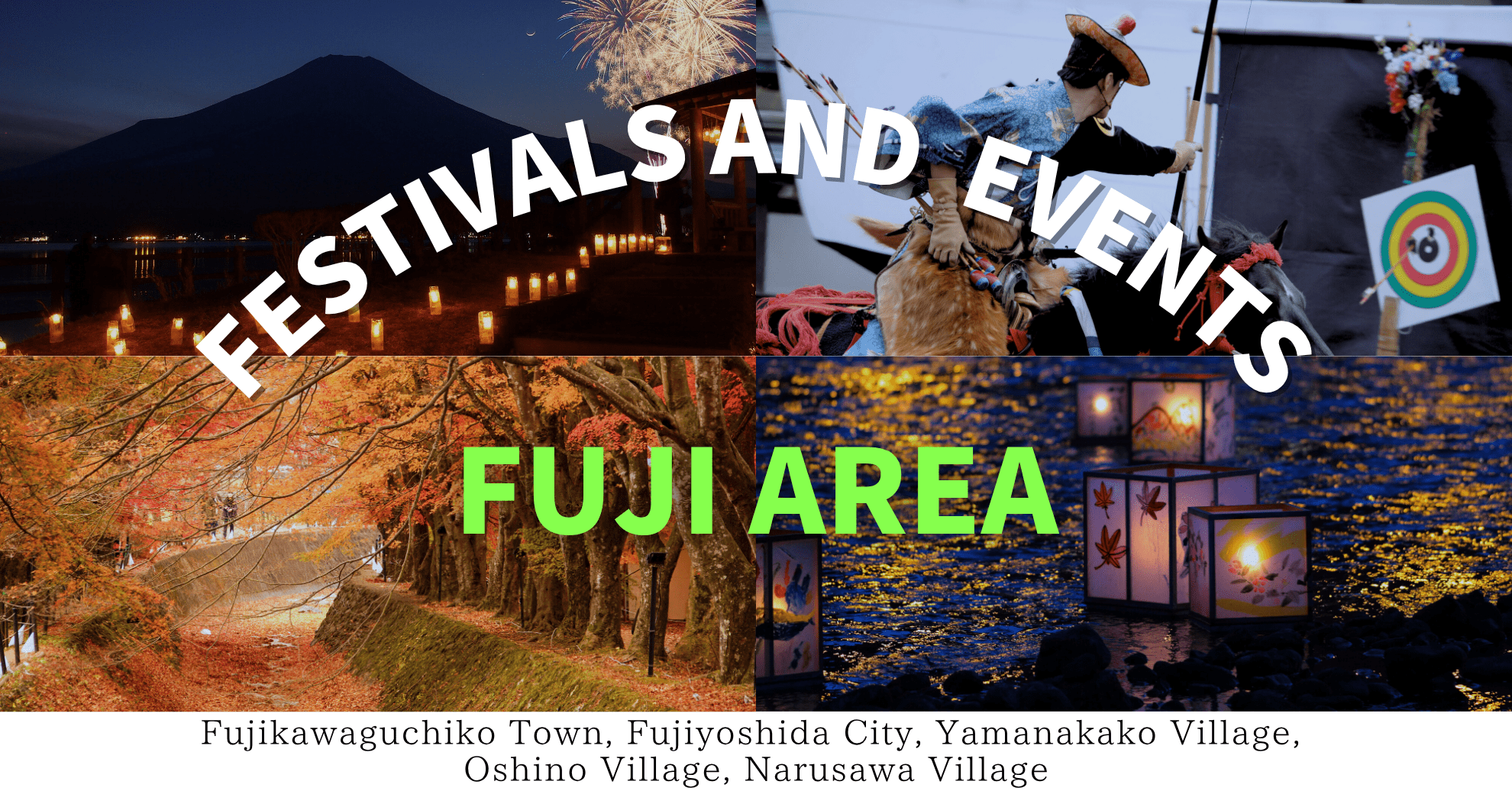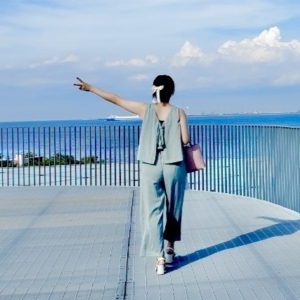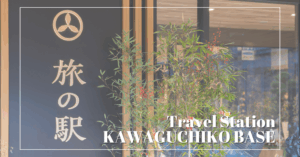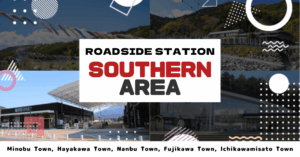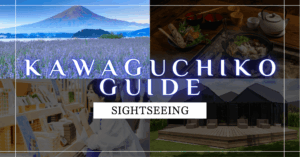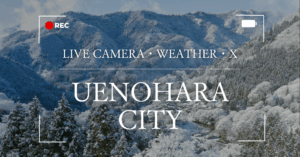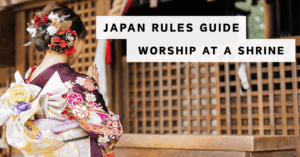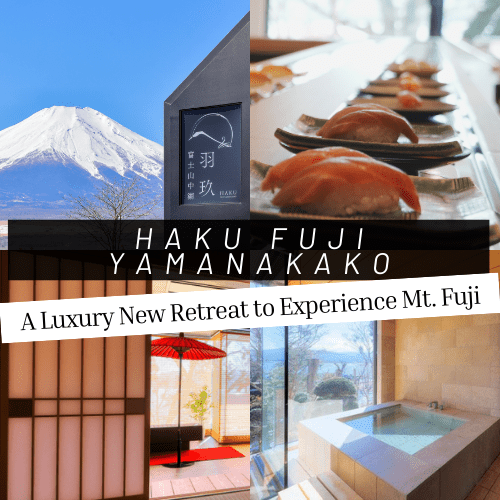With over 1,300 Asama Shrines across Japan, these sacred sites share a deep connection with Mt. Fuji. Since ancient times, people have revered the mountain, interpreting its eruptions as signs of divine anger, and built shrines to honor and appease the mountain deity.
This faith has been passed down through generations, leading to the spread of Asama Shrines throughout the country. In particular, the Mt. Fuji area is home to many historically significant shrines, each with its own unique traditions and characteristics.
From shrines nestled in breathtaking natural landscapes, to those with centuries of history, or closely tied to the traditions of Mt. Fuji climbing, Asama Shrines offer a wide variety of spiritual benefits and a sense of peace to all who visit.
In this guide, we’ll introduce some of the most iconic Asama Shrines that have walked hand in hand with Mt. Fuji through history, and explore their fascinating backgrounds and highlights.
What is an Asama Shrine?
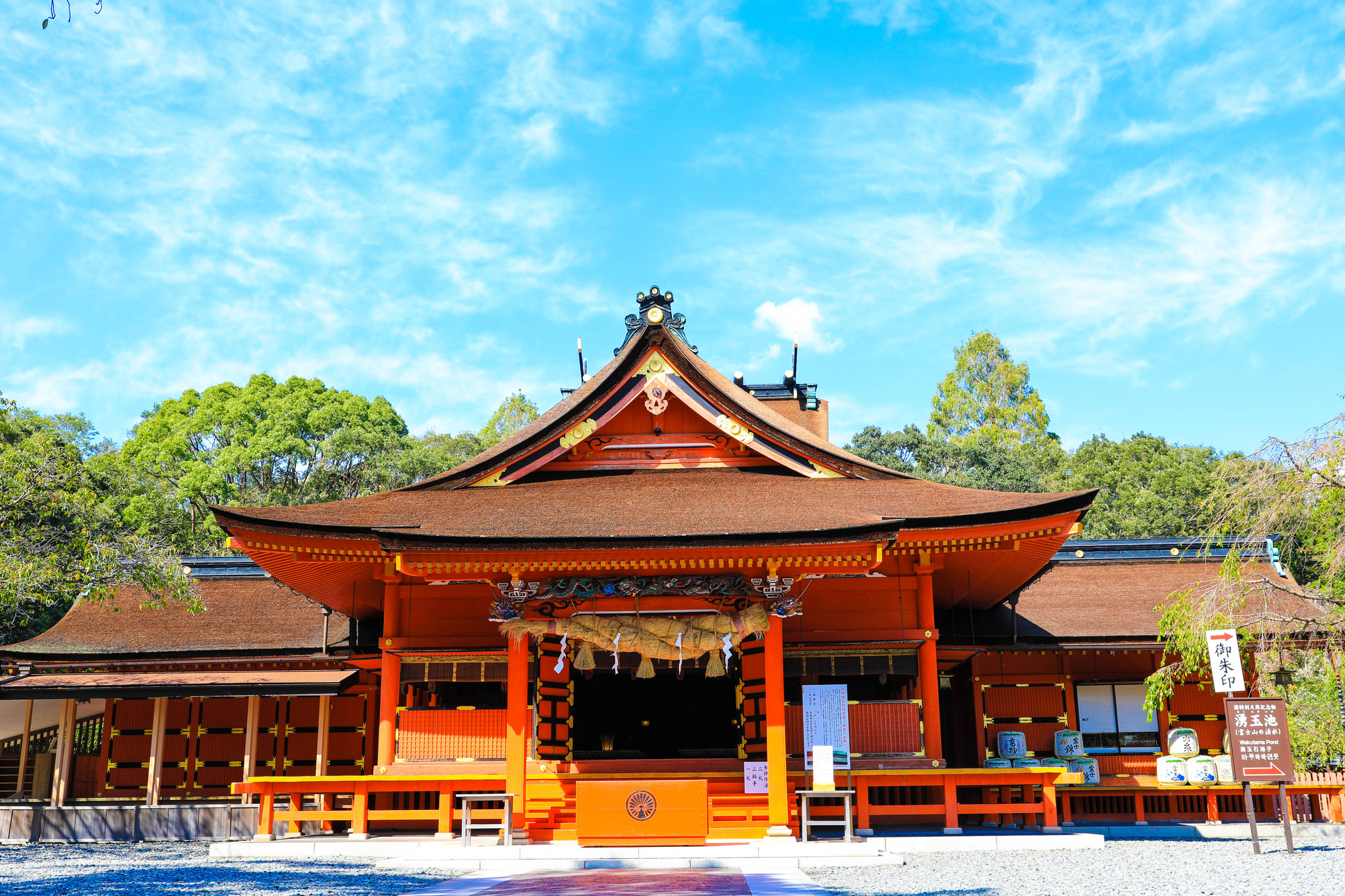
Asama Shrines are dedicated to Asama-Ōkami (Konohanasakuya-hime no Mikoto), the goddess who has been worshiped as the deification of Mt. Fuji in the tradition of Fuji faith.
Since ancient times, Mt. Fuji has been revered as a sacred mountain inhabited by divine spirits. However, beginning around 700,000 years ago, the mountain’s volcanic activity intensified, causing great damage to surrounding communities.
These eruptions were believed to be the result of the goddess Asama-Ōkami’s anger. To appease her and prevent further disasters, shrines were built to honor her—marking the origin of Asama Shrines.
From there, faith in Mt. Fuji spread across Japan, and today there are over 1,300 Asama Shrines nationwide. The head shrine is the Fujisan Hongū Sengen Taisha in Fujinomiya City, Shizuoka, which we will introduce later in this article.
Kitaguchi Hongū Fuji Sengen Shrine
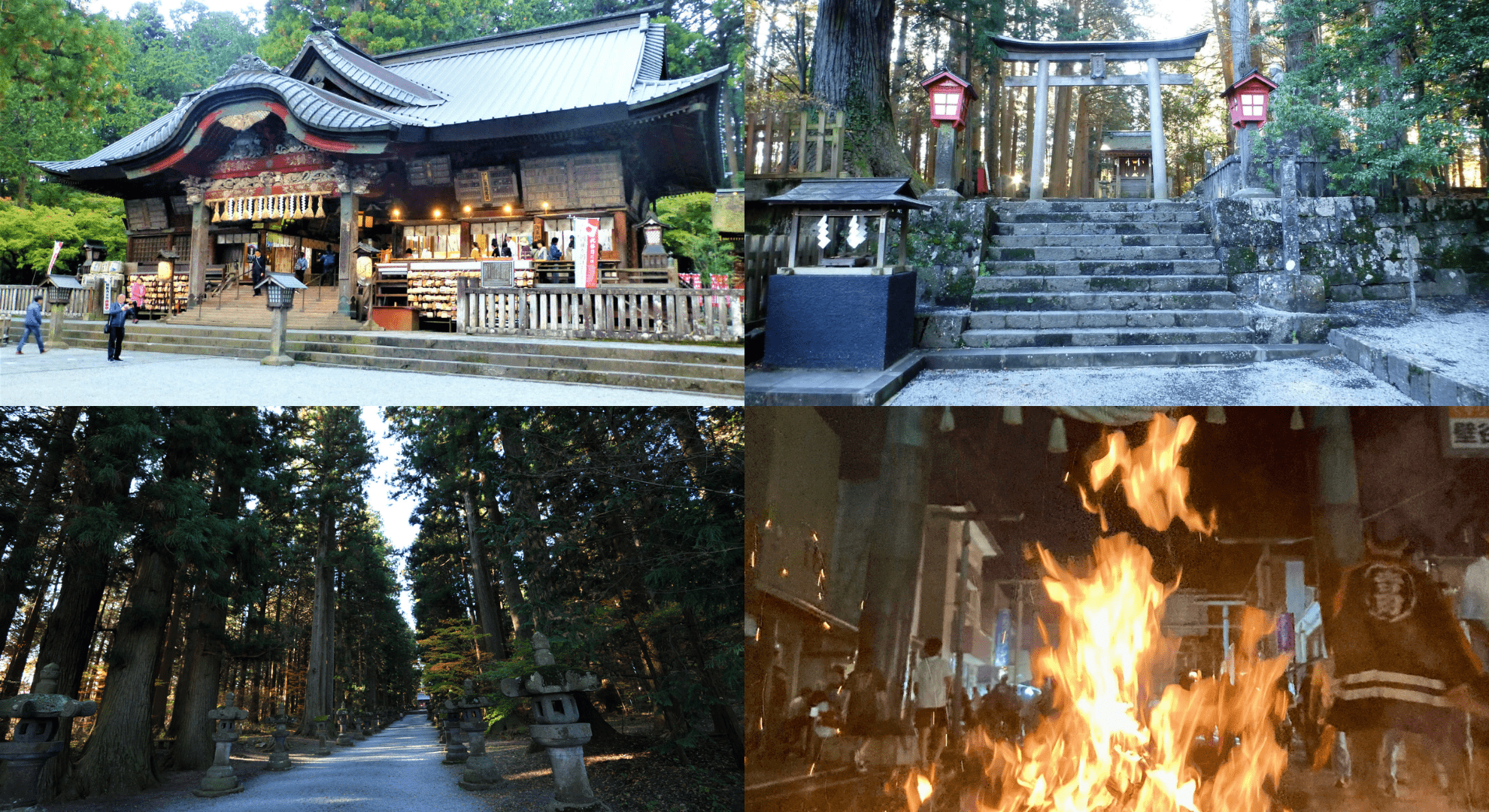
With a history of nearly 1,900 years, Kitaguchi Hongū Fuji Sengen Shrine is one of the most important centers of faith dedicated to Mt. Fuji.
Since ancient times, Mt. Fuji has been revered as a sacred mountain (“Reihō”), symbolizing Japan’s traditions of nature worship and mountain spirituality. This shrine was originally established as a sacred site where rituals were performed while gazing up at the majestic peak from afar.
It is also known as the starting point of the Yoshida Trail, the most popular of the four main climbing routes up Mt. Fuji. Many believe the shrine radiates particularly strong spiritual energy, making it an essential stop before beginning the ascent.
Furthermore, the shrine is the venue of the Yoshida Fire Festival, celebrated every year on August 26–27. Recognized as one of Japan’s Three Most Unique Festivals, this event features giant torches set ablaze to honor the mountain and pray for protection.
Today, Kitaguchi Hongū Fuji Sengen Shrine is recognized as part of the UNESCO World Cultural Heritage “Fujisan, sacred place and source of artistic inspiration,” and continues to attract visitors seeking both spiritual blessings and a deep connection to Mt. Fuji’s natural beauty.
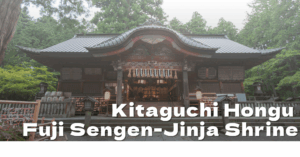
【Kitaguchi Hongū Fuji Sengen Shrine】
| Address | 5558 Kamiyoshida, Fujiyoshida, Yamanashi 403-0005 |
|---|---|
| Phone | 0555-22-0221 |
| Website | https://www.sengenjinja.jp/index.html |
Arakura Fuji Sengen Shrine
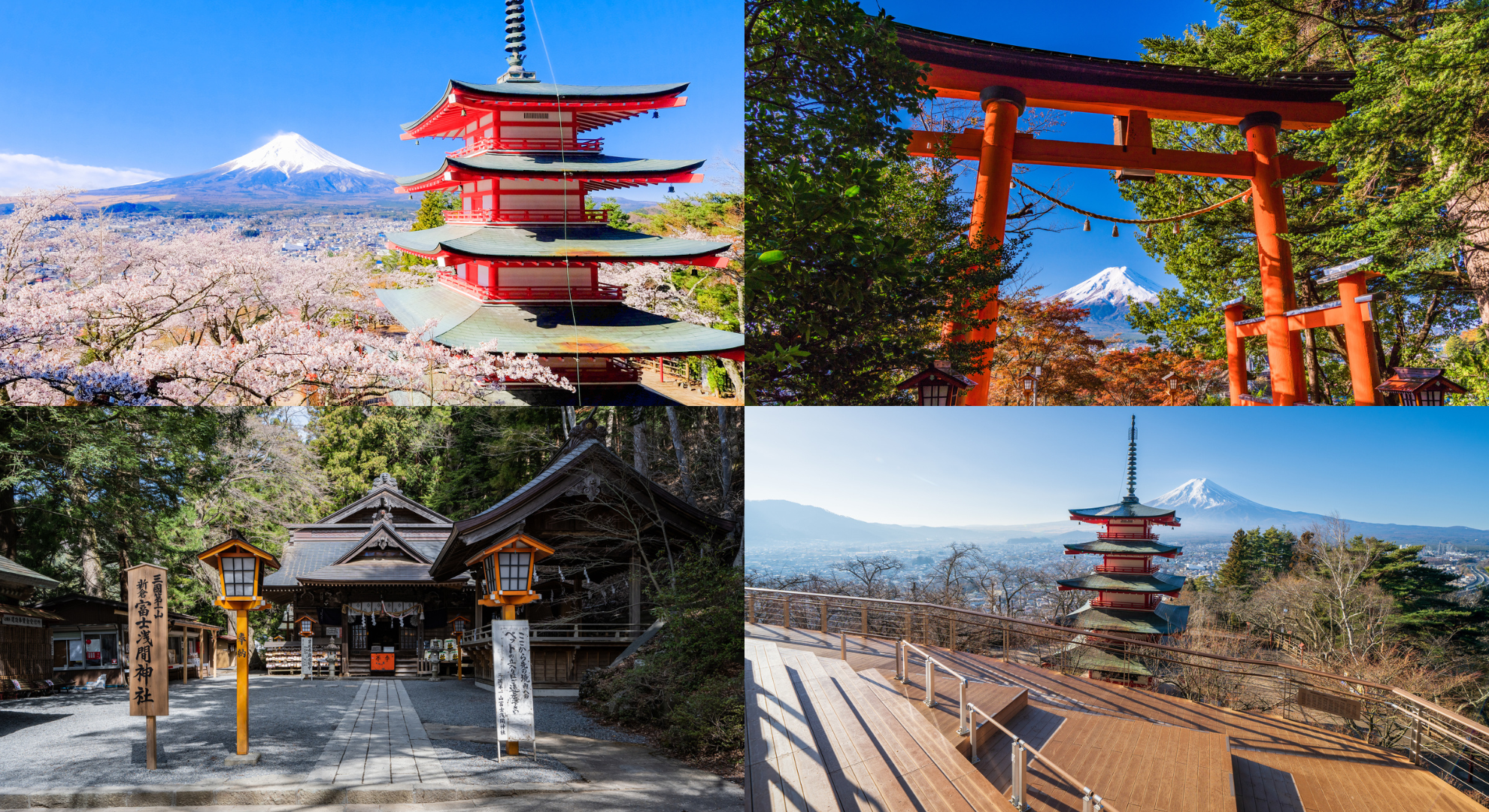
Located within Arakurayama Sengen Park, a famous destination known for its red torii gate and the five-story Chureito Pagoda, Arakura Fuji Sengen Shrine is one of the most visited spiritual and scenic spots near Mt. Fuji.
The shrine is renowned for its torii gate framing spectacular views of Mt. Fuji, which change dramatically with the seasons and time of day. From the fiery glow of the “Red Fuji” at sunrise to snow-capped winter peaks, the scenery here is truly breathtaking.
Each season offers a different charm: cherry blossoms in spring, lush greenery in summer, vibrant autumn foliage, and serene snow landscapes in winter. This makes the shrine and park a year-round favorite for both locals and international travelers.
One of the most popular souvenirs is the goshuincho (shrine stamp book) featuring the iconic view of Mt. Fuji with cherry blossoms and the five-storied pagoda—a perfect keepsake to remember your visit.
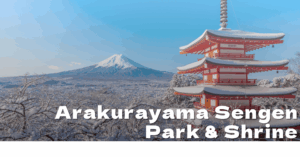
【Arakura Fuji Sengen Shrine】
| Address | 2-4-1 Asama, Fujiyoshida, Yamanashi 403-0031 |
|---|---|
| Phone | 0555-23-2697 |
| Website | https://www.arakurafujisengen.com/ |
Kawaguchi Asama Shrine
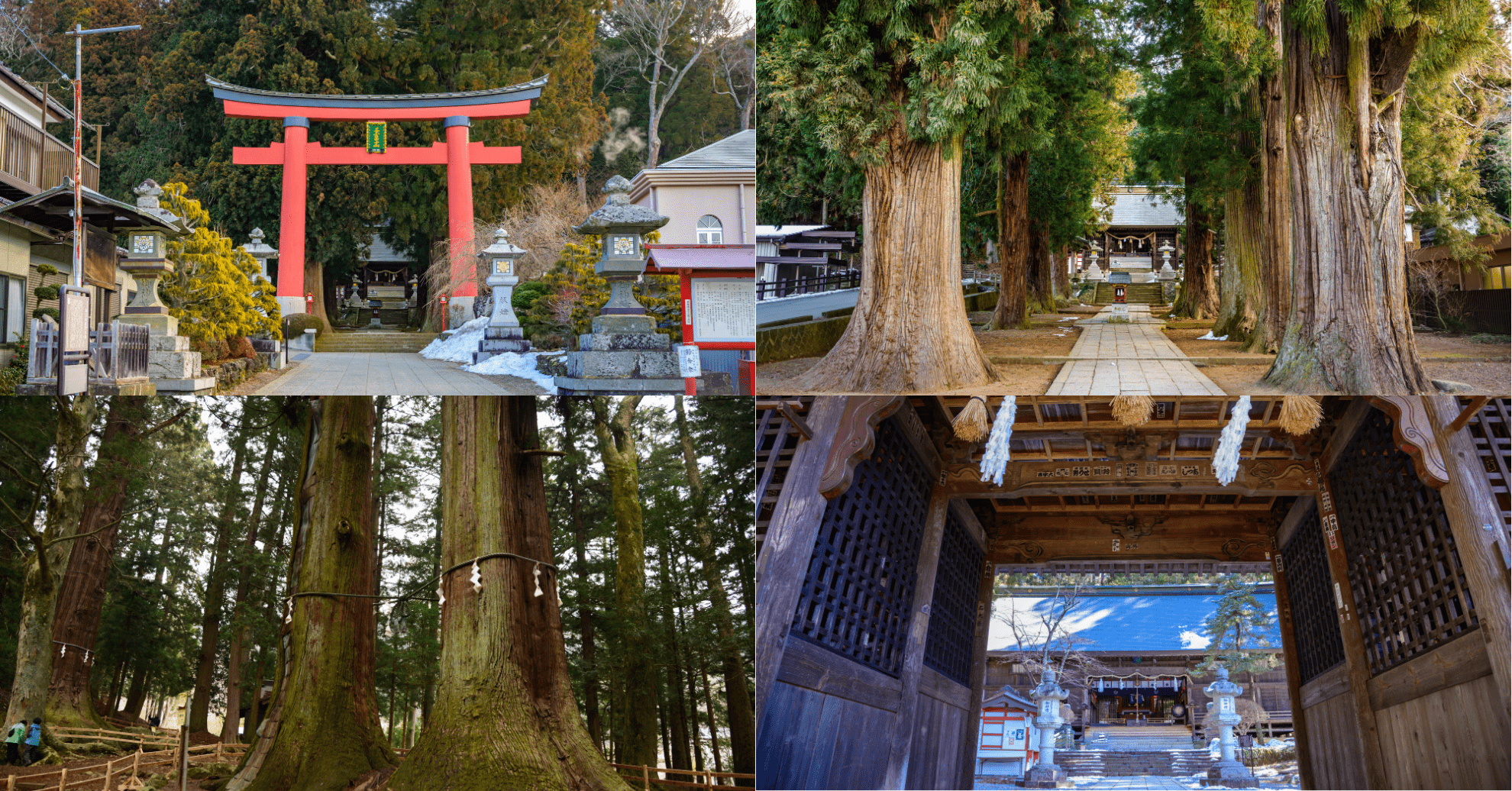
Steeped in history and spiritual significance, Kawaguchi Asama Shrine is one of the most enchanting Shinto shrines around Mt. Fuji. Visitors are welcomed by a majestic approach lined with towering cedar trees and the iconic 1,200-year-old Seven Sacred Cedars, creating a truly mystical atmosphere.
Recognized as part of the UNESCO World Cultural Heritage sites, the shrine continues to host traditional ceremonies that remain closely tied to Mt. Fuji. Among them is the Daidai Kagura Festival, held every year on July 28 for over 1,100 years, where the sacred Chigo-no-Mai (Dance of the Children) is performed—a rare opportunity to witness living cultural heritage.
For travelers interested in Japanese history, culture, and spirituality, Kawaguchi Asama Shrine is not only a sightseeing spot but also a meaningful destination to experience the deep roots of Mt. Fuji worship.
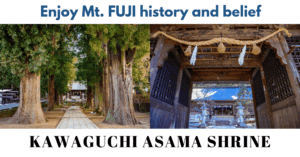
【Kawaguchi Asama Shrine】
| Address | 1 Kawaguchi, Fujikawaguchiko Town, Minamitsuru District, Yamanashi 401-0304 |
|---|---|
| Phone | 0555-76-7186 |
| Website | https://asamajinja.or.jp/ |
Fuji Omuro Sengen Shrine
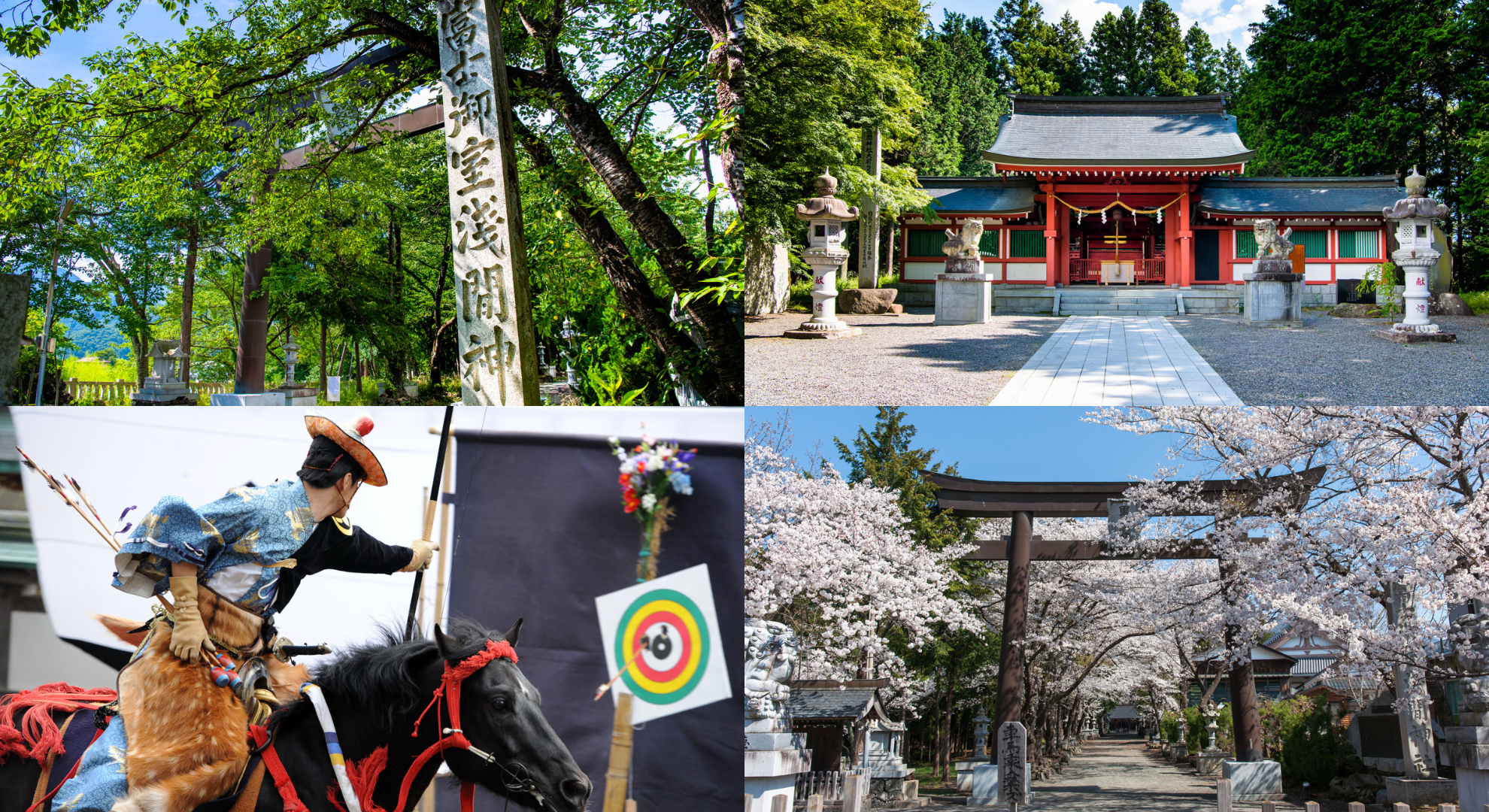
Founded in 699 A.D., Fuji Omuro Sengen Shrine is said to have originally enshrined its main sanctuary at the Second Station of Mt. Fuji. Revered by many warlords including the legendary Takeda Shingen, the shrine continues to draw worshippers and visitors today.
Although the main sanctuary was relocated from the Second Station to its present site in 1973, the shrine retains its sacred atmosphere and historical significance, making it one of the most spiritual power spots around Mt. Fuji.
One of its most celebrated traditions is the Yabusame Festival, held annually on April 29. This spectacular ritual, featuring mounted archers shooting arrows while galloping on horseback, has been preserved for over 900 years. It is a powerful symbol of the region’s heritage and continues to captivate both worshippers and tourists alike.
The shrine also offers a wide variety of omikuji (fortune slips) and beautifully designed goshuincho (seal stamp books), making it a delightful place to collect keepsakes of your visit.
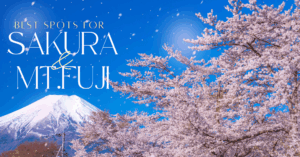
【Fuji Omuro Sengen Shrine】
| Address | 3951 Katsuyama, Fujikawaguchiko Town, Minamitsuru District, Yamanashi 401-0310 |
|---|---|
| Phone | 0555-83-2399 |
| Website | https://fujiomurosengenjinja.jp/ |
Fujisan Shimomiya Komuro Sengen Shrine
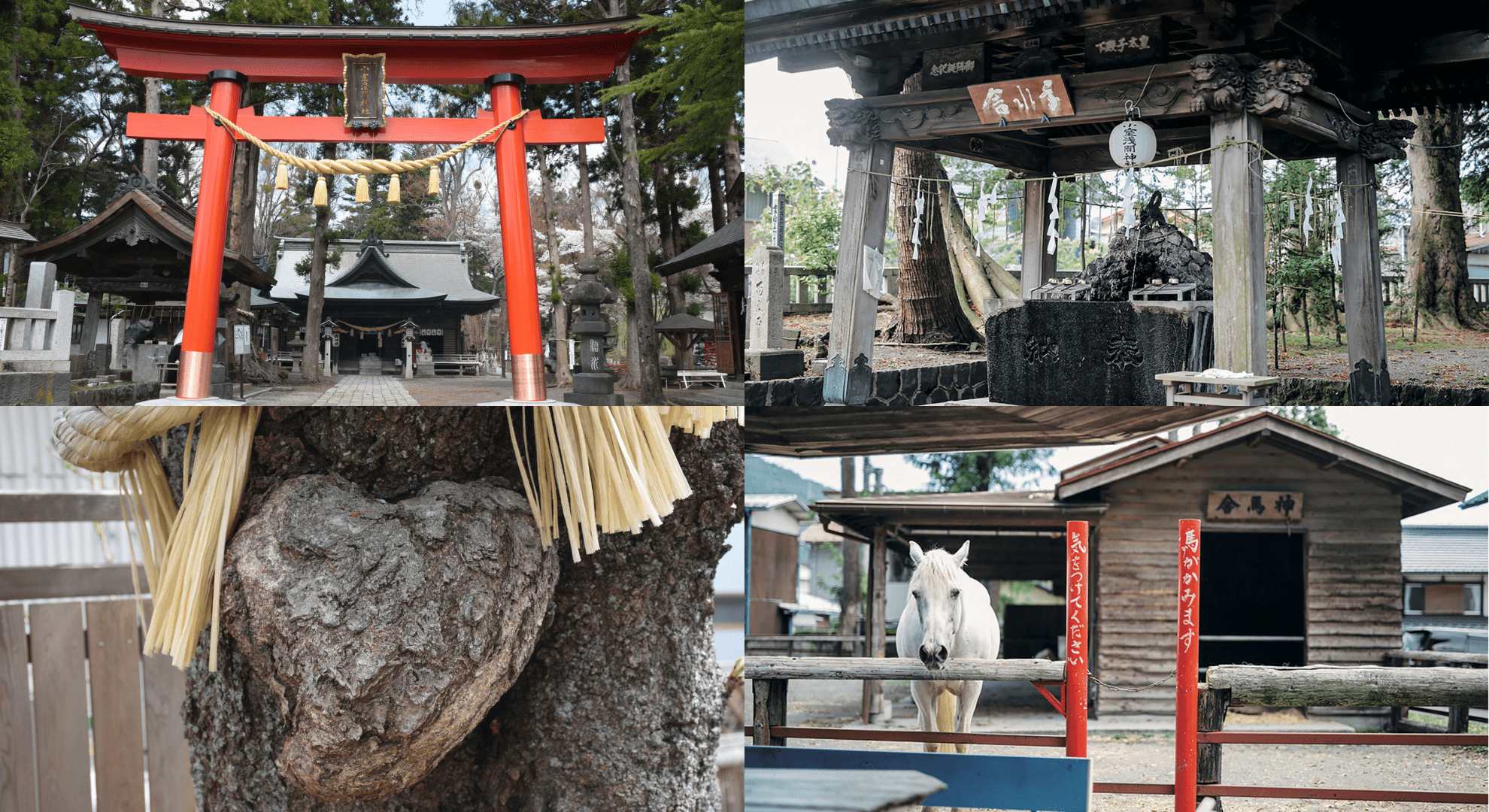
Located in Fujiyoshida City, Fujisan Shimomiya Komuro Sengen Shrine is a historic Shinto shrine where visitors are warmly greeted by a sacred horse (shinme) kept in the shrine’s stables. These divine horses are considered to be messengers of the gods and play an important role in the shrine’s traditions.
The shrine is particularly famous for its unique form of divination. During the Yabusame Festival, you can witness the rare ritual of Batei Uranai (horse-hoof fortune telling), where the hoofprints left by galloping horses are interpreted to predict the fortunes of the local community. For centuries, these fortunes were believed to influence not only the year’s harvest but also the lives of the people.
Adding to its mystical charm, a few years ago a heart-shaped knot appeared on one of the cherry trees along the shrine’s approach. Revered as a sacred tree of matchmaking, it has since become a popular love power spot, attracting visitors who pray for romance and fulfilling relationships.
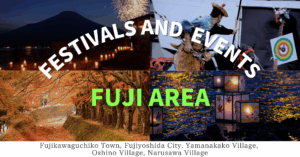
【Fujisan Shimomiya Komuro Sengen Shrine】
| Address | 3-32-18 Shimoyoshida, Fujiyoshida City, Yamanashi 403-0004 |
|---|---|
| Phone | 0555-22-1025 |
| Website | http://www.fgo.jp/yabusame/ |
Oshino Hakkai Sengen Shrine
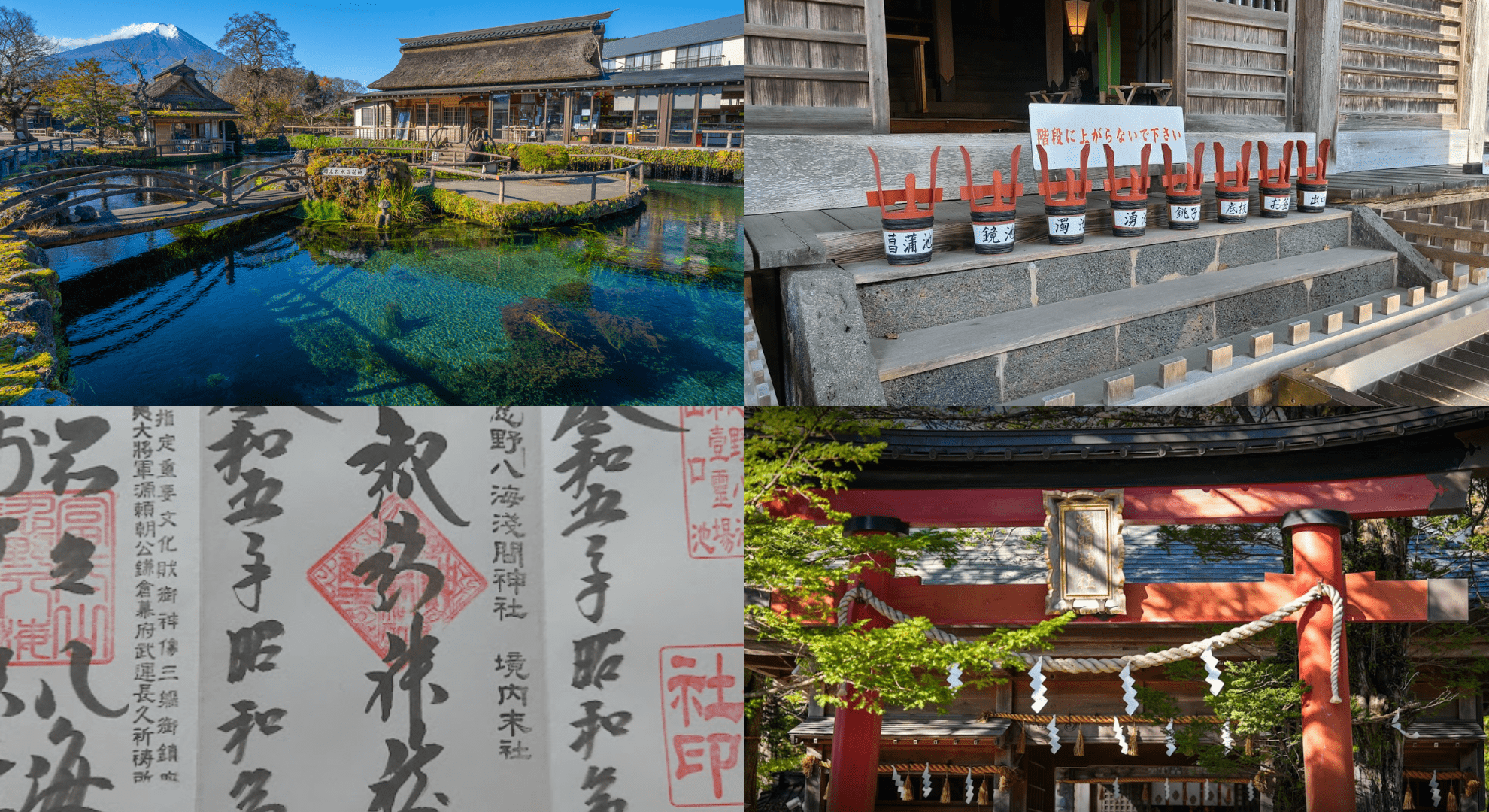
Located near the World Heritage Site “Oshino Hakkai”, a group of eight crystal-clear spring ponds formed by Mt. Fuji’s snowmelt water filtering underground over many years, Oshino Hakkai Sengen Shrine serves as the guardian shrine of these sacred waters.
According to tradition, the shrine was rebuilt at its current location in 1186, the same year Oshino Hakkai was said to have appeared. The tranquil grounds feature a temizuya (purification basin) fed by the pure spring water, as well as old trees that exude an atmosphere of timeless reverence.
A particularly unique detail is that the ink used for the shrine’s goshuin (seal stamps) is made with water from Oshino Hakkai itself, giving visitors a rare and meaningful keepsake of their visit.
With its serene setting, historical depth, and spiritual connection to Mt. Fuji, the shrine is a perfect stop when exploring the Oshino Hakkai springs.
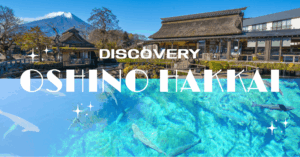
【Oshino Hakkai Sengen Shrine】
| Address | 456 Shibokusa, Oshino Village, Minamitsuru District, Yamanashi 401-0511 |
|---|---|
| Phone | 0555-84-2857 |
| Website | – |
Kai Province Ichinomiya Sengen Shrine
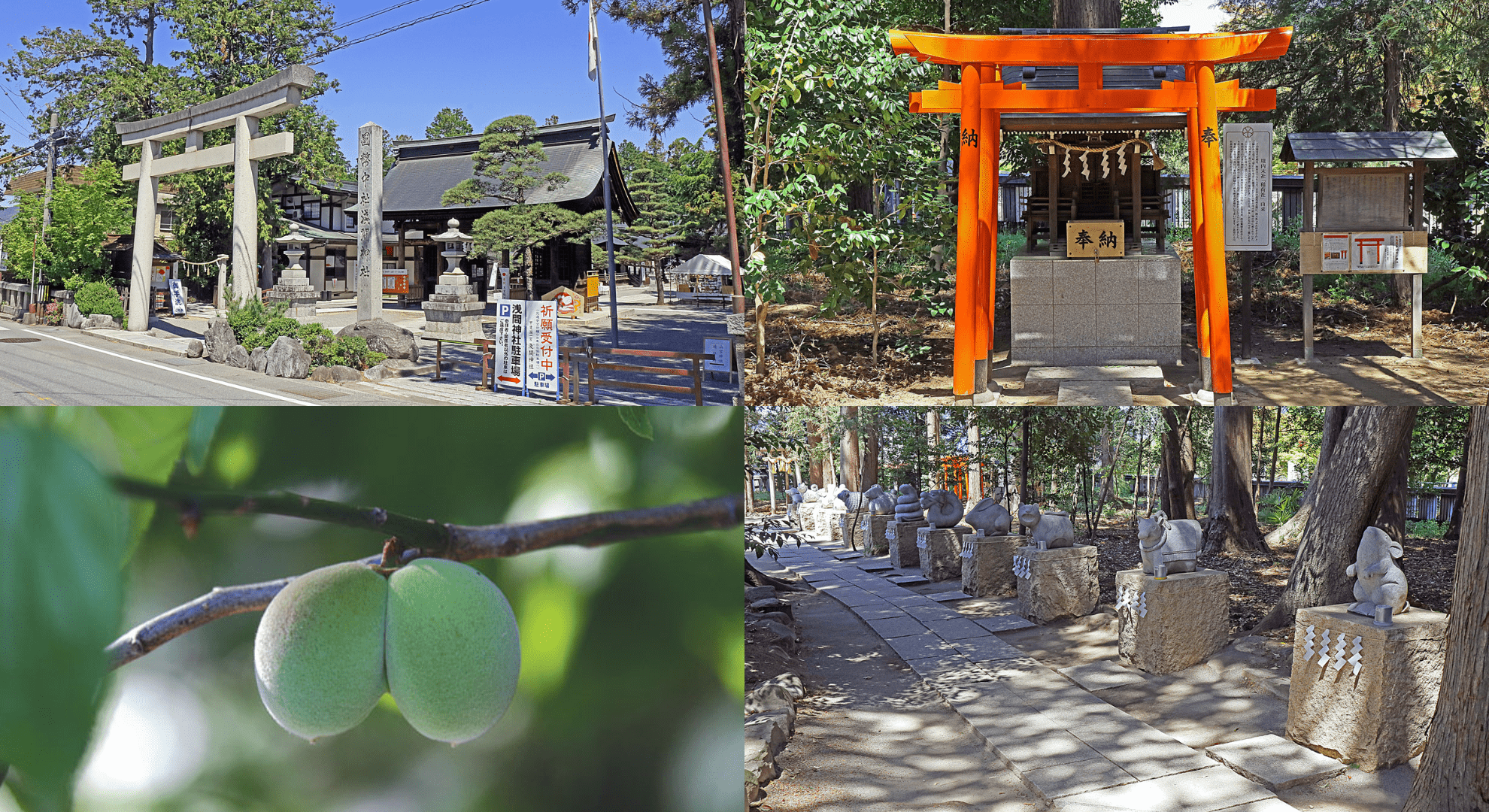
Kai Province Ichinomiya Sengen Shrine stands out with its unique collection of human-shaped stone statues and zodiac guardian statues. Visitors are encouraged to pray at the statue representing either the zodiac animal of the current year or their birth year to receive blessings.
One of the highlights is the “Meoto Ume” (Married Plum Tree), a natural monument over 200 years old, located beside the main hall. This rare tree produces two fruits from a single blossom, symbolizing fertility and family prosperity. Many visitors come seeking its divine protection for descendants and harmonious family life.
Every year on April 15, the shrine hosts the traditional Omiyuki-san Festival, where men dressed as women carry a mikoshi (portable shrine) and march along the riverbanks, praying for protection against flooding. The lively and colorful ritual reflects the community’s deep connection with nature and faith.
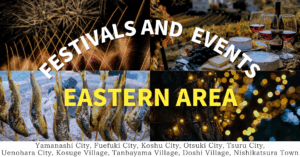
【Kai Province Ichinomiya Sengen Shrine】
| Address | 1684 Ichinomiya, Ichinomiya Town, Fuefuki, Yamanashi 405-0056 |
|---|---|
| Phone | 0553-47-0900 |
| Website | https://asamajinja.jp/ |
Ichikawago Ichinomiya Sengen Shrine
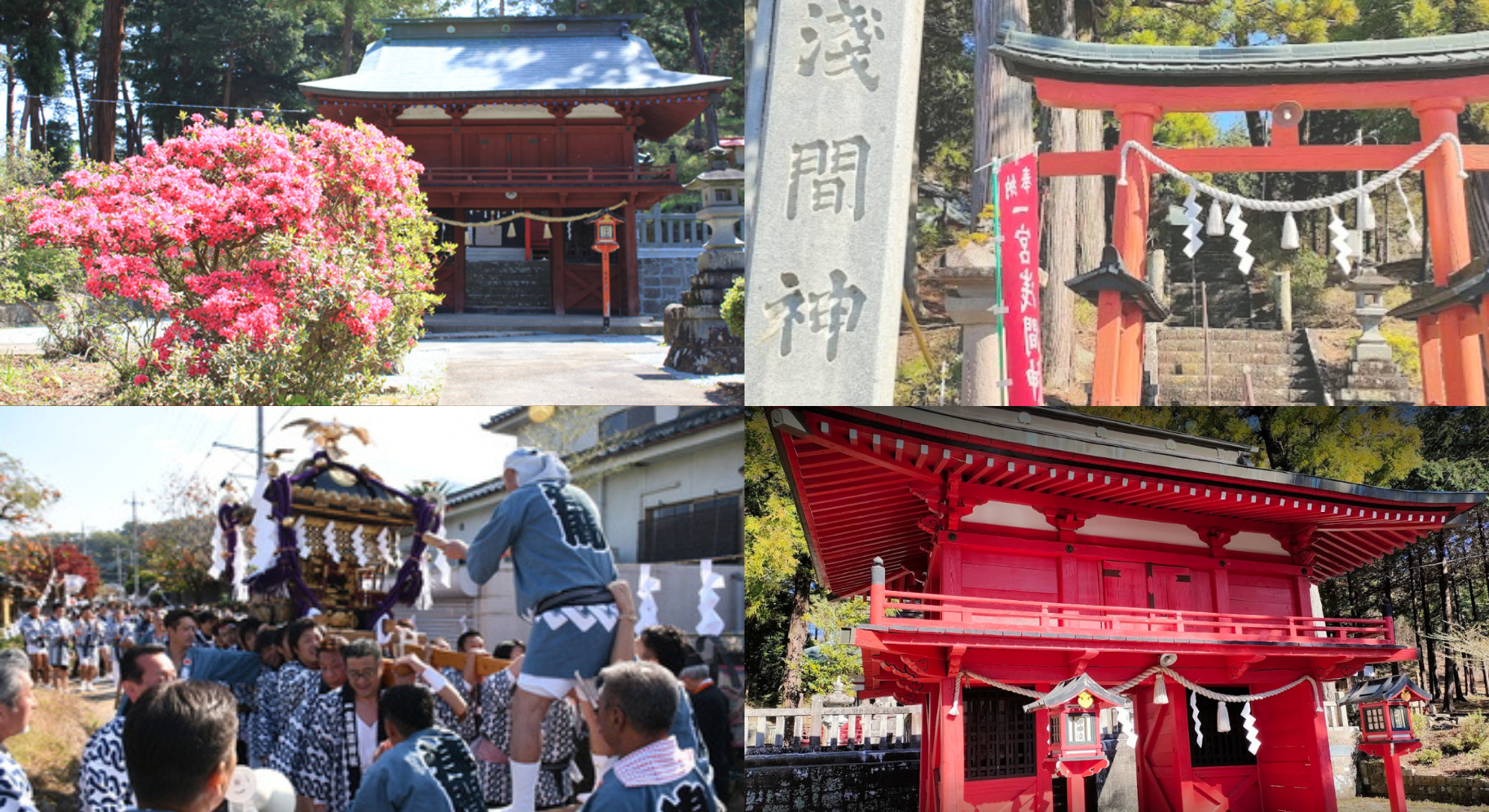
Nestled in Ichikawamisato, Ichikawago Ichinomiya Sengen Shrine is known for its breathtaking scenery, especially in May, when the shrine grounds are filled with blooming azaleas, turning the entire area a vivid pink.
The shrine’s striking vermilion-painted two-story gate and main hall stand out for their elegance and vibrant presence, captivating all who visit.
Every year on November 3, the Ichinomiya Sengen Shrine Annual Festival takes place. About 100 participants carry portable shrines (mikoshi) through the streets with powerful chants, creating a lively and energetic atmosphere unique to traditional Japanese festivals. The event draws many spectators and offers a chance to experience the region’s rich heritage and festive spirit up close.
【Ichikawago Ichinomiya Sengen Shrine】
| Address | 3696 Takada, Ichikawamisato, Nishiyatsushiro District, Yamanashi 409-3606 |
|---|---|
| Phone | 055-240-4157 |
| Website | – |
Higashiguchi Hongū Fuji Sengen Shrine
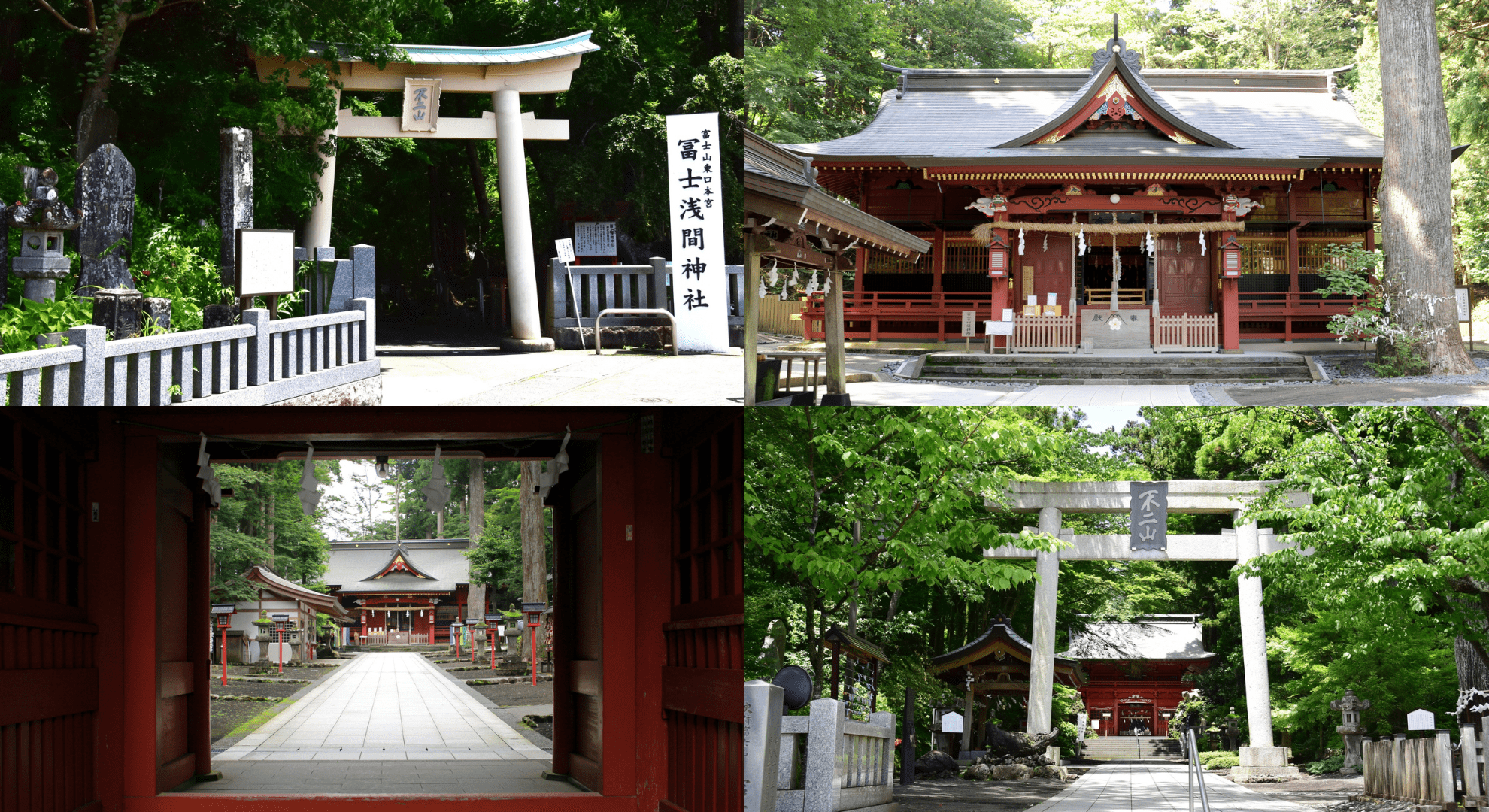
During the Edo period, this shrine was strongly revered by members of the Fujikō religious group, and even today it serves as the starting point for climbing Mt. Fuji via the Subashiri Trail from the mountain’s base.
Recognized as part of the World Cultural Heritage of Mt. Fuji, it remains less crowded compared to other shrines, making it an excellent choice for those who wish to pray in a peaceful atmosphere.
Behind the main hall, visitors can admire the majestic backdrop of Mt. Fuji, while the 80 Fujikō stone monuments scattered around the grounds offer a glimpse into the history of Mt. Fuji worship and pilgrimage.
The shrine is believed to bestow blessings for safe journeys and protection, and during the summer climbing season, many mountaineers visit to pray for safety before their ascent.
Interestingly, the shrine is also known as the site of Japan’s very first birdwatching event, commemorated by the “Monument of the Wild Bird Society of Japan” within the precincts. As you stroll through the grounds, take a moment to listen to the birdsong that still fills the air.
【Higashiguchi Hongū Fuji Sengen Shrine】
| Address | 126 Subashiri, Oyama Town, Sunto District, Shizuoka 410-1431 |
|---|---|
| Phone | 0550-75-2038 |
| Website | https://higashiguchi-fujisengenjinja.or.jp/ |
Fujisan Hongū Sengen Taisha & Okumiya Sengen Taisha
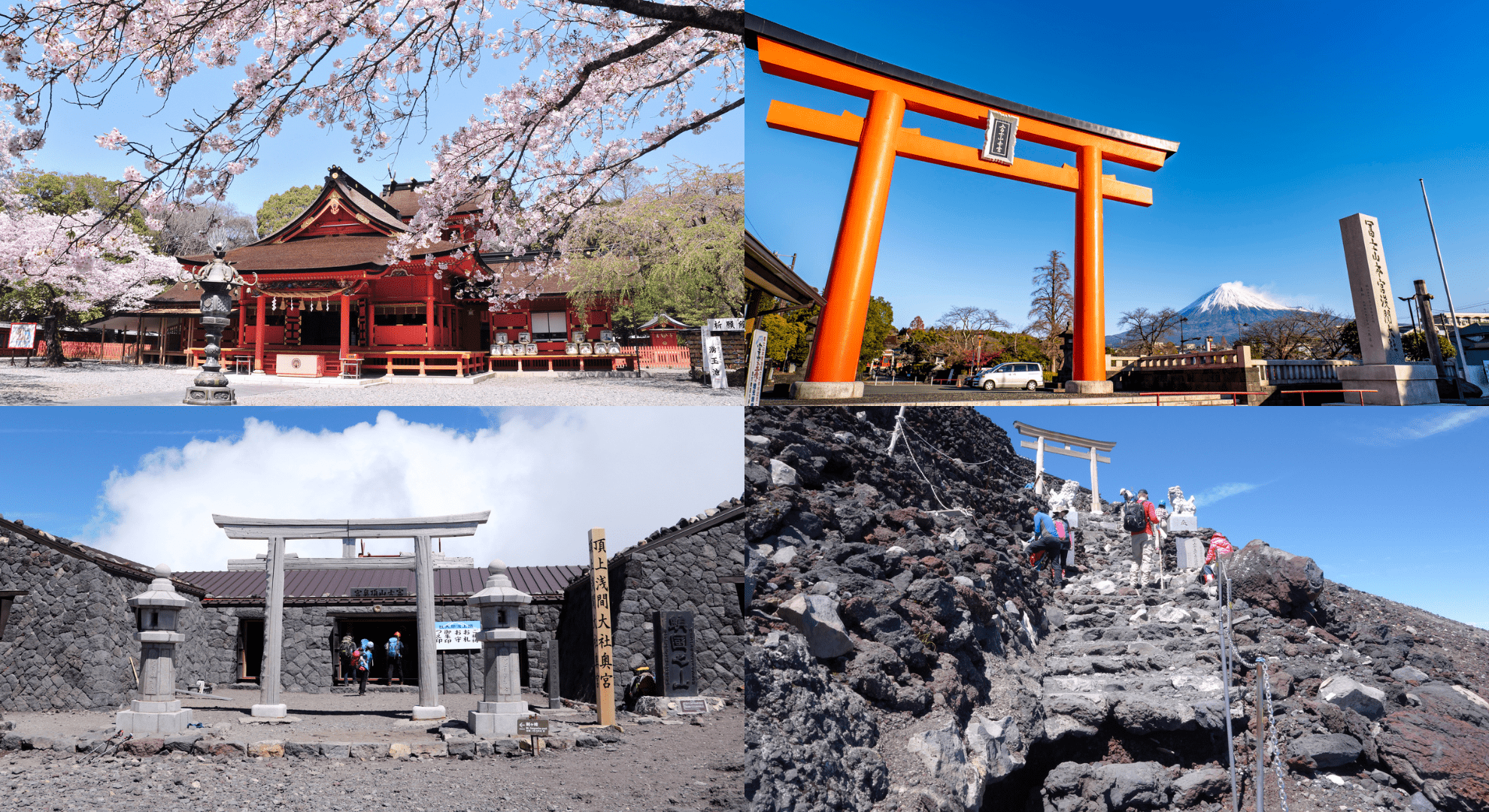
Built in 1604 under the order of Tokugawa Ieyasu, the first shogun of the Edo period, Fujisan Hongū Sengen Taisha is one of the most historically significant shrines dedicated to Mt. Fuji worship.
Though much of the original structure has collapsed due to earthquakes, the Main Hall (Honden), Worship Hall (Haiden), Offering Hall (Heiden), and Two-story Gate (Rōmon) still remain, continuing to impress worshippers with their grandeur.
What makes each structure unique?
<Honden (Main Hall)>
Designated as an Important Cultural Property of Japan, the honden here is unique for being two-storied, unlike most shrines. It enshrines Konohanasakuya-hime, the goddess who embodies beauty, fertility, and strength, famous for giving birth amid flames. She is also associated with the ephemeral beauty of cherry blossoms, making this shrine a celebrated cherry blossom viewing spot.
<Haiden (Worship Hall)>
The hall in front of the honden where worshippers gather to pray and make their offerings.
<Heiden (Offering Hall)>
The hall where sacred offerings are presented to the deities, standing between the honden and haiden.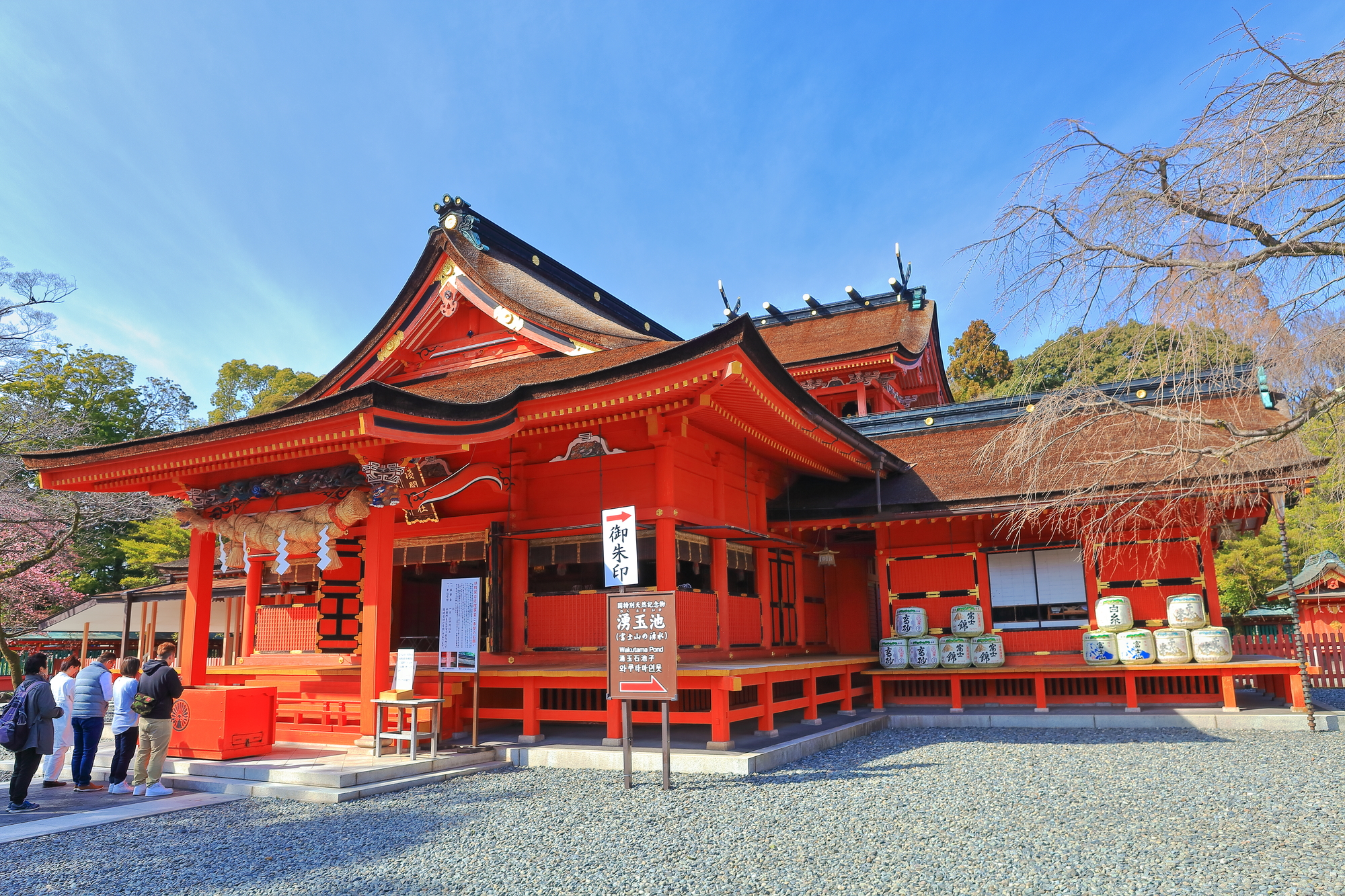
<Rōmon (Two-story Gate)>
A majestic gate marking the entrance, often seen at large shrines and temples.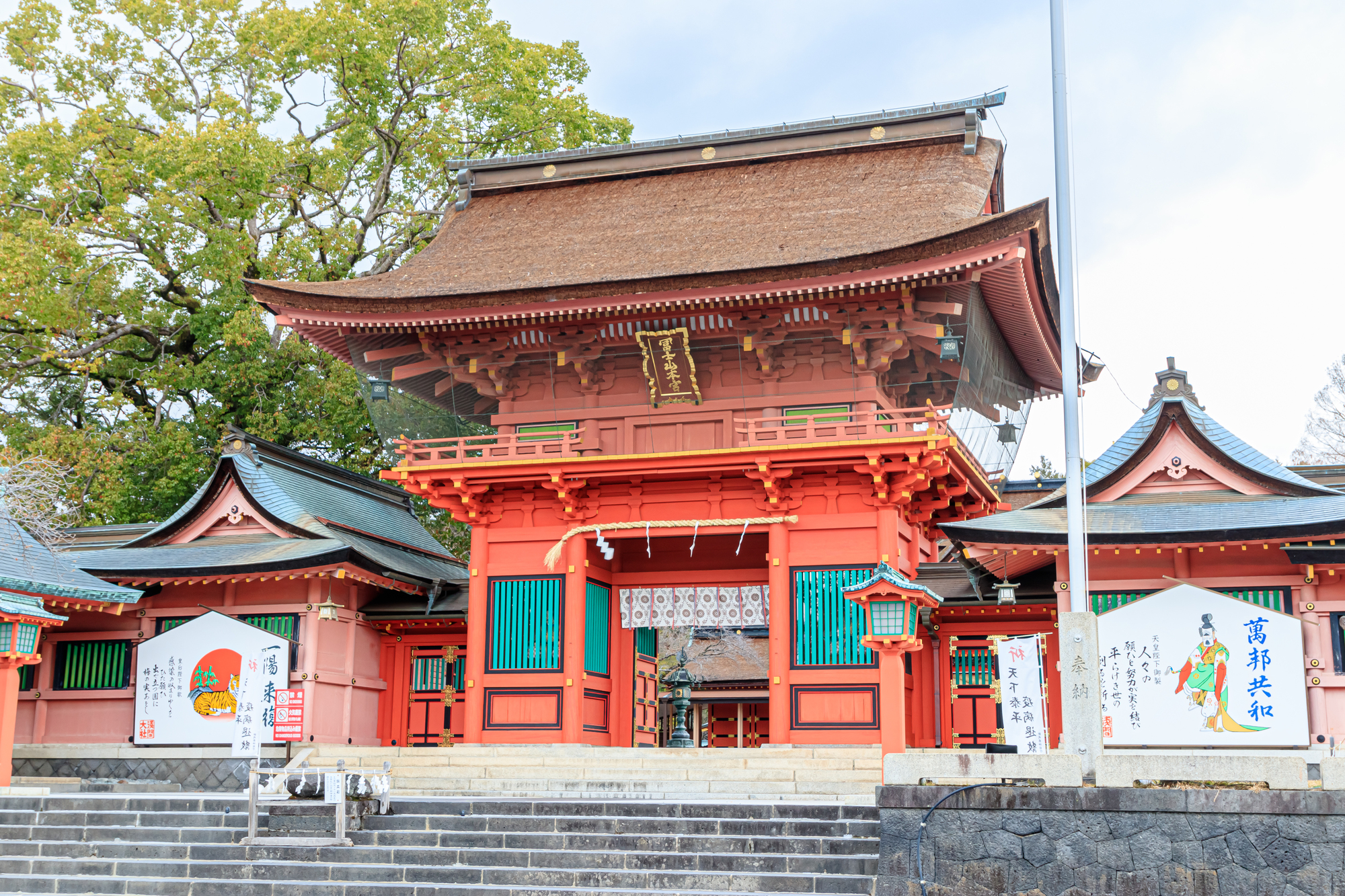
At the summit of Mt. Fuji lies Okumiya Sengen Taisha, considered the inner sanctuary of Fujisan worship. From the 8th station upward, the entire summit area is regarded as the shrine’s sacred precinct.
Pilgrims and climbers alike visit this shrine to pay respects upon reaching Japan’s highest peak. The goshuin (shrine seal) from Okumiya is particularly special, stamped with ink mixed with actual lava sand from Mt. Fuji.
【Fujisan Hongū & Okumiya Sengen Taisha】
| Address | 1-1 Miyamachi, Fujinomiya, Shizuoka 418-0067 |
|---|---|
| Phone | 0544-27-2002 |
| Website | http://fuji-hongu.or.jp/sengen/ |
Summary
In this article, we introduced some of the most representative Sengen Shrines around Mt. Fuji. Deeply connected to the history of Fujisan worship, these shrines are not only places where you can experience culture and tradition, but also popular as spiritual power spots believed to bring blessings and good fortune.
At JAPANOPIA, we also feature many other fascinating destinations in Yamanashi Prefecture, including shrines, sacred sites, and places said to bring good luck. Be sure to check them out when planning your next trip!
Recommended for You! Featured Articles You May Also Like
-

Festivals & Events in Fuji Area | Enjoy the Spirit of Mt. Fuji!
-


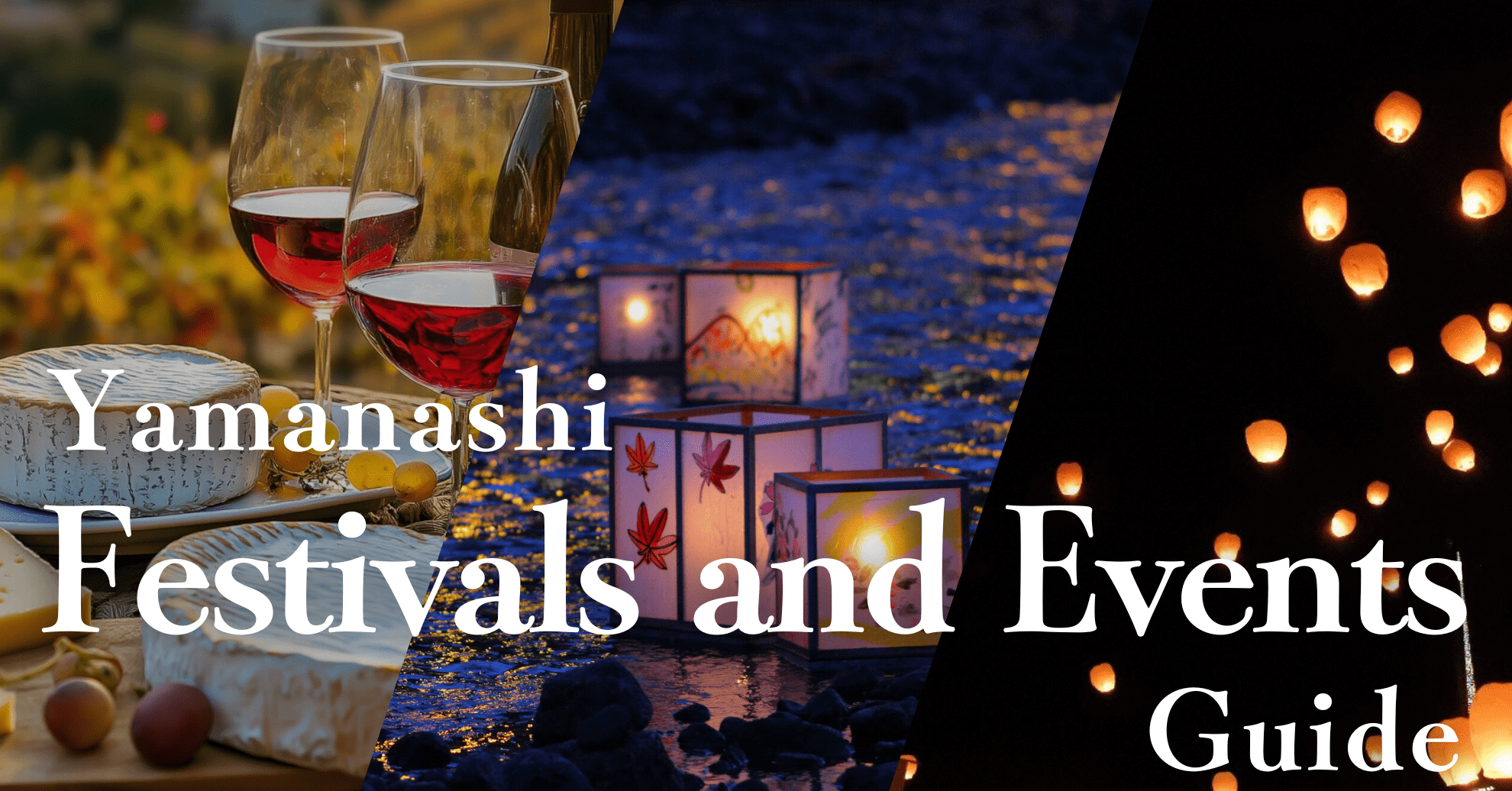
Discover the Best of Yamanashi: Seasonal Festivals & Events Guide
-


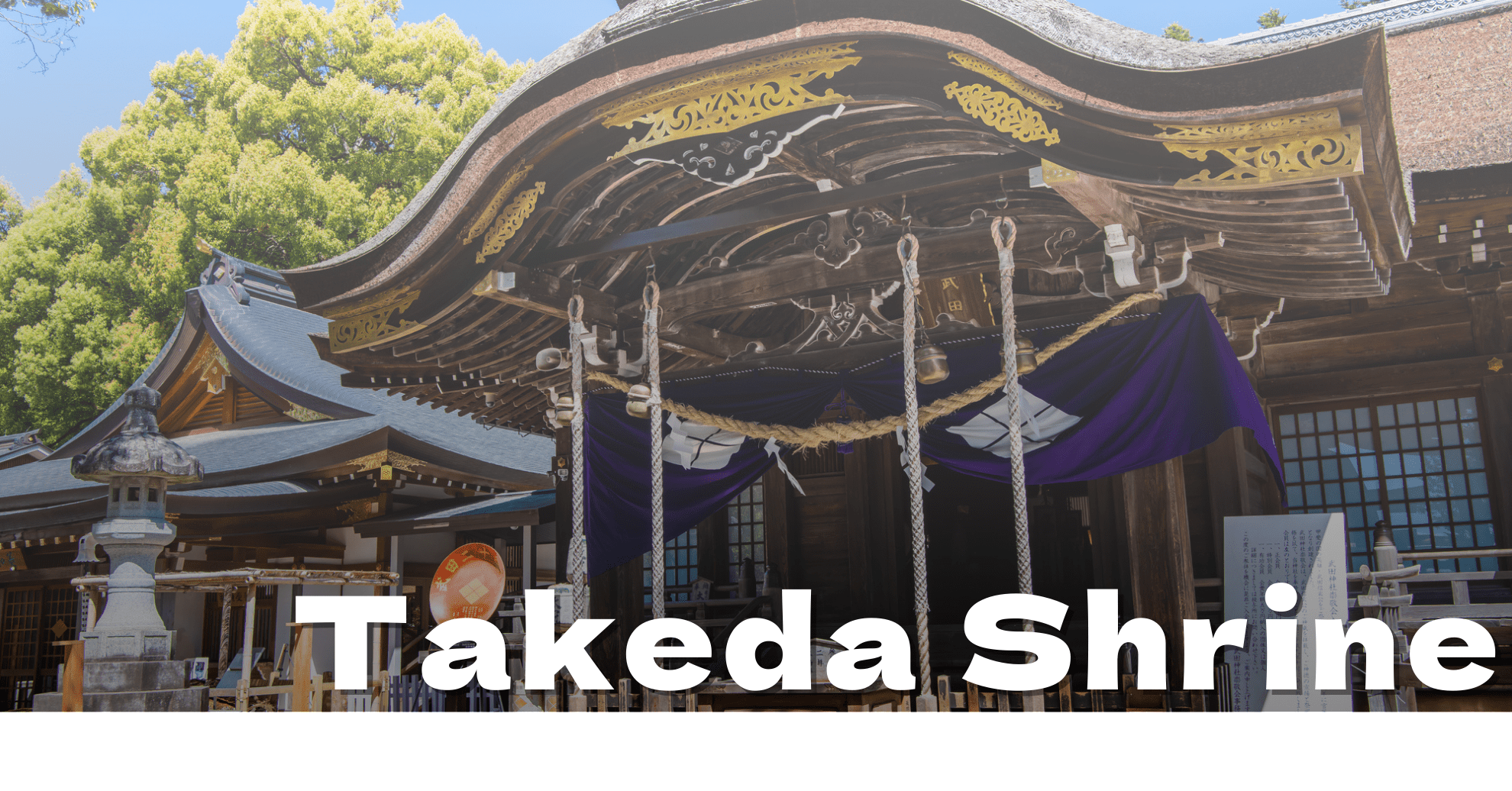
Yamanashi’s Ultimate Power Spot! A Complete Guide to Takeda Shrine
-


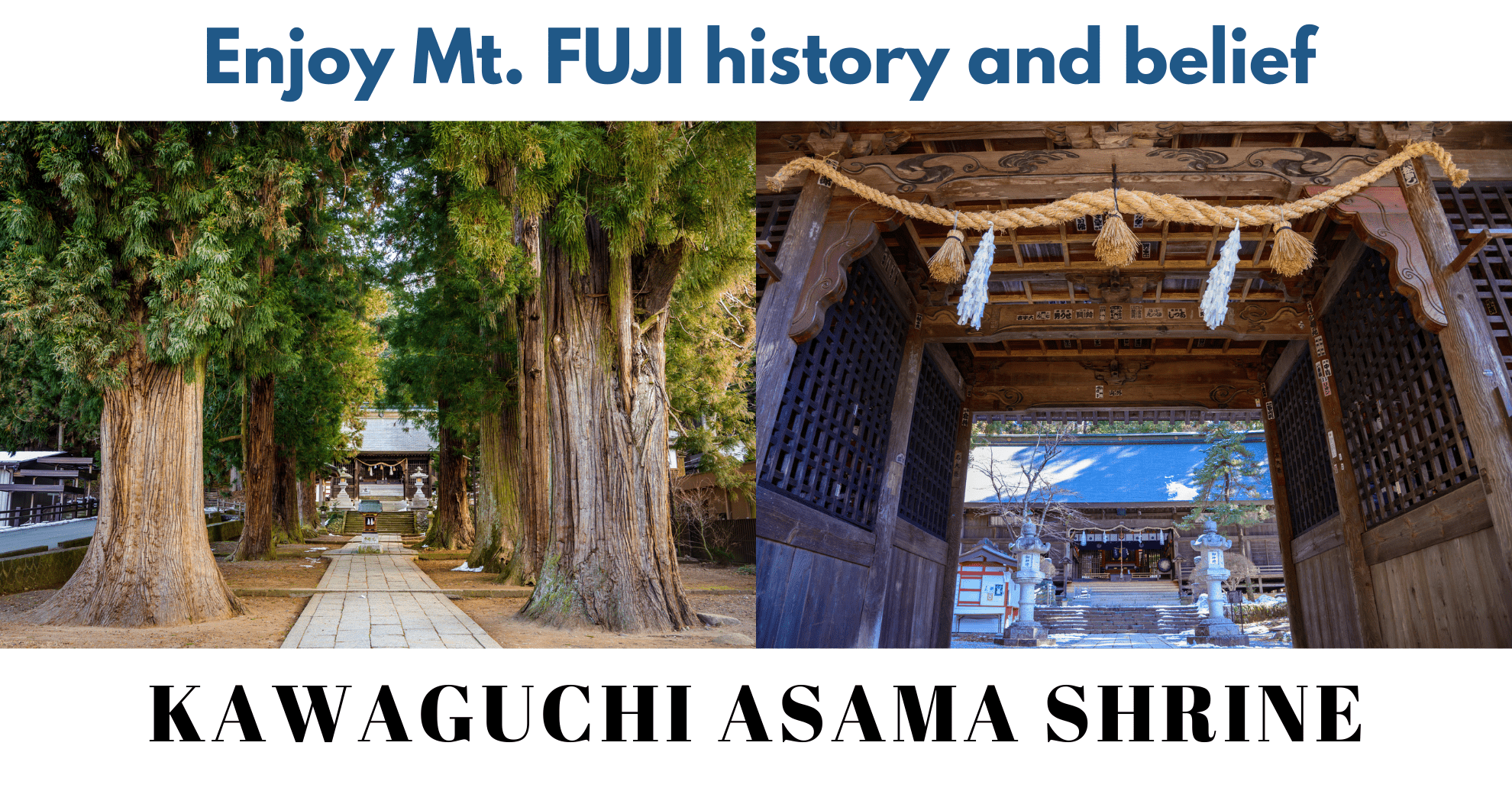
Kawaguchi Asama Shrine: A Complete Guide to History, Highlights, and Access
-


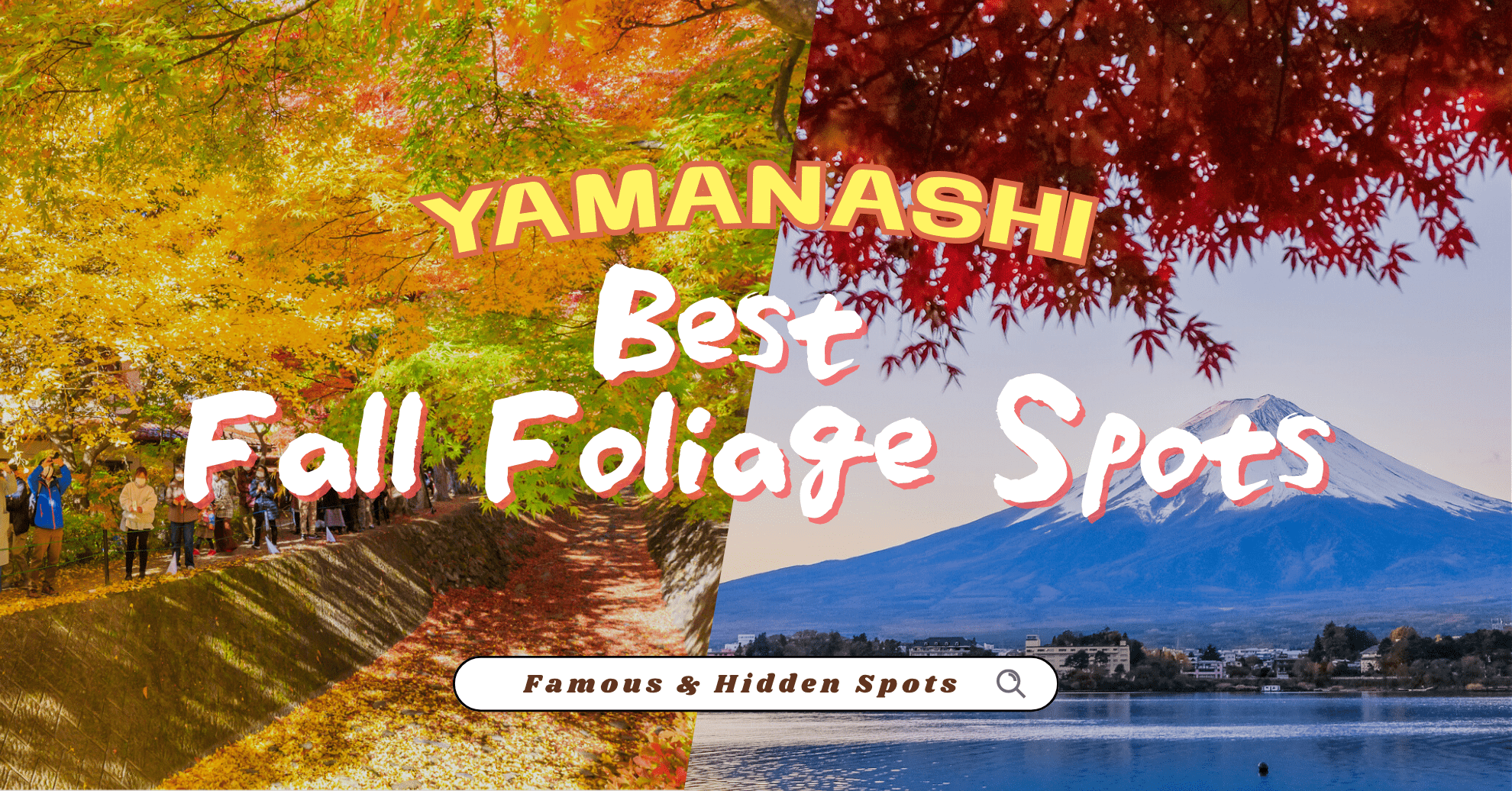
【Famous & Hidden Spots】Yamanashi Autumn Foliage Guide 2025
-


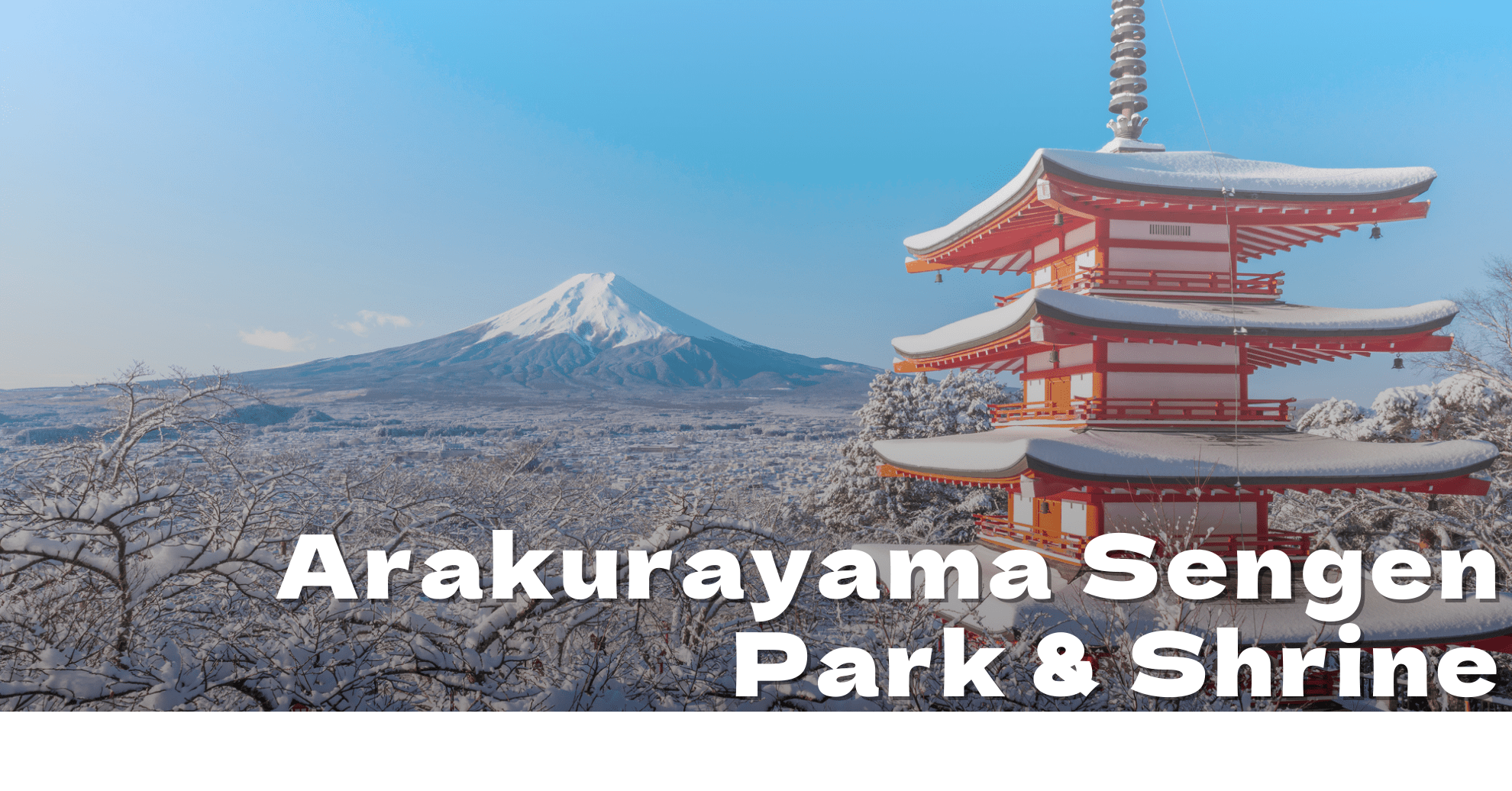
Mt. Fuji and the Five-Storied Pagoda: The Stunning Power Spot of Arakurayama Sengen Park × Arakura Fuji Sengen Shrine

